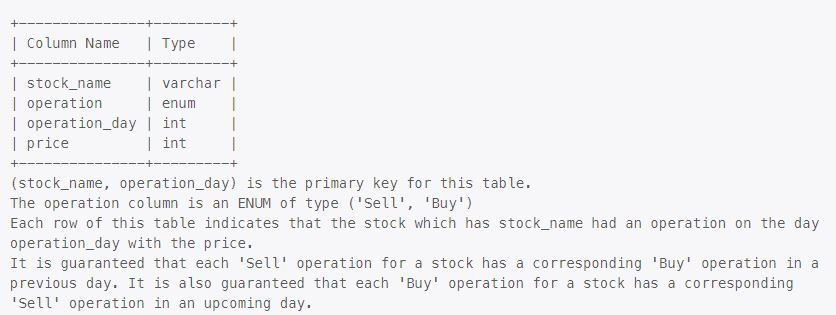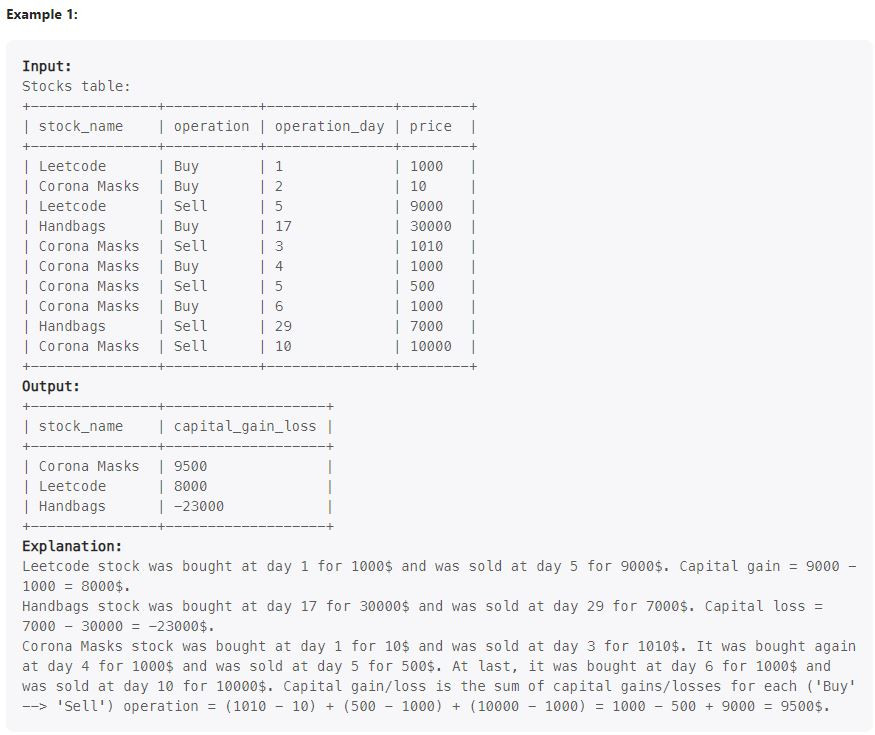LEETCODE SQL挑戰超過時間只能重新等,
但發現可以先點出題目來寫
第一題一直被判定成含有禁止字元,改用截圖的方式呈現。



這一題要算股票買賣的收益,最快的理解方法就是直接看例子,
Corona Masks 買了1000元與賣了9000元,賺了8000,
可以看成BUY就是-1000,SELL是+9000
P.S.SUM(IF(operation ='Sell',price,0))結構是SUM( IF() ,THEN() ,ELSE() )
SELECT stock_name ,SUM(IF(operation ='Sell',price,0))
-SUM(IF(operation ='Buy',price,0)) AS capital_gain_loss
FROM Stocks
GROUP BY stock_name
+---------------+---------+
| Column Name | Type |
+---------------+---------+
| id | int |
| name | varchar |
+---------------+---------+
id is the primary key for this table.
name is the name of the user.
Table: Rides
+---------------+---------+
| Column Name | Type |
+---------------+---------+
| id | int |
| user_id | int |
| distance | int |
+---------------+---------+
id is the primary key for this table.
user_id is the id of the user who traveled the distance "distance".
Write an SQL query to report the distance traveled by each user.
Return the result table ordered by travelled_distance in descending order, if two or more users traveled the same distance, order them by their name in ascending order.
The query result format is in the following example.
Example 1:
Input:
Users table:
+------+-----------+
| id | name |
+------+-----------+
| 1 | Alice |
| 2 | Bob |
| 3 | Alex |
| 4 | Donald |
| 7 | Lee |
| 13 | Jonathan |
| 19 | Elvis |
+------+-----------+
Rides table:
+------+----------+----------+
| id | user_id | distance |
+------+----------+----------+
| 1 | 1 | 120 |
| 2 | 2 | 317 |
| 3 | 3 | 222 |
| 4 | 7 | 100 |
| 5 | 13 | 312 |
| 6 | 19 | 50 |
| 7 | 7 | 120 |
| 8 | 19 | 400 |
| 9 | 7 | 230 |
+------+----------+----------+
Output:
+----------+--------------------+
| name | travelled_distance |
+----------+--------------------+
| Elvis | 450 |
| Lee | 450 |
| Bob | 317 |
| Jonathan | 312 |
| Alex | 222 |
| Alice | 120 |
| Donald | 0 |
+----------+--------------------+
Explanation:
Elvis and Lee traveled 450 miles, Elvis is the top traveler as his name is alphabetically smaller than Lee.
Bob, Jonathan, Alex, and Alice have only one ride and we just order them by the total distances of the ride.
Donald did not have any rides, the distance traveled by him is 0.
這一題要計算旅行的里程,跑越多距離的排越上面(降序),
距離一樣則依名字排(升序),ifnull之前有寫到過,遇到NULL就把它變成0處理,
ORDER BY 2 DESC, 1的結構是SELECT 1,2去表示的,
就不用打成ORDER BY travelled_distance DESC, name
SELECT
name,
ifnull(sum(distance),0) AS travelled_distance
FROM Users u
LEFT JOIN Rides r
ON r.user_id = u.id
GROUP BY u.id
ORDER BY 2 DESC, 1
+----------------+---------+
| Column Name | Type |
+----------------+---------+
| user_id | int |
| join_date | date |
| favorite_brand | varchar |
+----------------+---------+
user_id is the primary key of this table.
This table has the info of the users of an online shopping website where users can sell and buy items.
Table: Orders
+---------------+---------+
| Column Name | Type |
+---------------+---------+
| order_id | int |
| order_date | date |
| item_id | int |
| buyer_id | int |
| seller_id | int |
+---------------+---------+
order_id is the primary key of this table.
item_id is a foreign key to the Items table.
buyer_id and seller_id are foreign keys to the Users table.
Table: Items
+---------------+---------+
| Column Name | Type |
+---------------+---------+
| item_id | int |
| item_brand | varchar |
+---------------+---------+
item_id is the primary key of this table.
Write an SQL query to find for each user, the join date and the number of orders they made as a buyer in 2019.
Return the result table in any order.
The query result format is in the following example.
Example 1:
Input:
Users table:
+---------+------------+----------------+
| user_id | join_date | favorite_brand |
+---------+------------+----------------+
| 1 | 2018-01-01 | Lenovo |
| 2 | 2018-02-09 | Samsung |
| 3 | 2018-01-19 | LG |
| 4 | 2018-05-21 | HP |
+---------+------------+----------------+
Orders table:
+----------+------------+---------+----------+-----------+
| order_id | order_date | item_id | buyer_id | seller_id |
+----------+------------+---------+----------+-----------+
| 1 | 2019-08-01 | 4 | 1 | 2 |
| 2 | 2018-08-02 | 2 | 1 | 3 |
| 3 | 2019-08-03 | 3 | 2 | 3 |
| 4 | 2018-08-04 | 1 | 4 | 2 |
| 5 | 2018-08-04 | 1 | 3 | 4 |
| 6 | 2019-08-05 | 2 | 2 | 4 |
+----------+------------+---------+----------+-----------+
Items table:
+---------+------------+
| item_id | item_brand |
+---------+------------+
| 1 | Samsung |
| 2 | Lenovo |
| 3 | LG |
| 4 | HP |
+---------+------------+
Output:
+-----------+------------+----------------+
| buyer_id | join_date | orders_in_2019 |
+-----------+------------+----------------+
| 1 | 2018-01-01 | 1 |
| 2 | 2018-02-09 | 2 |
| 3 | 2018-01-19 | 0 |
| 4 | 2018-05-21 | 0 |
+-----------+------------+----------------+
這一題要找出各廠商2019的訂單數,同時還要列出註冊日,
找2019直覺就用LIKE "2019%",到order_date找2019開頭的訂單,
需要熟練的地方是LEFT JOIN ON這個關聯的用法,真的很常用到,
還有只要有用COUNT這類數學函式,就要用GROUP BY做排序。
SELECT U.user_id AS buyer_id ,join_date ,COUNT(order_date) AS orders_in_2019
FROM Users U
LEFT JOIN Orders O ON U.user_id=O.buyer_id
AND O.order_date LIKE "2019%"
GROUP BY U.user_id
